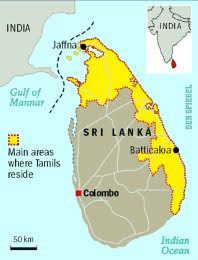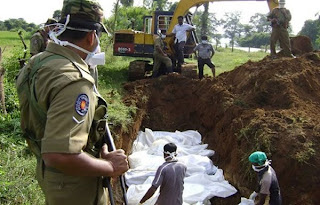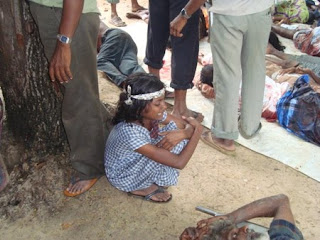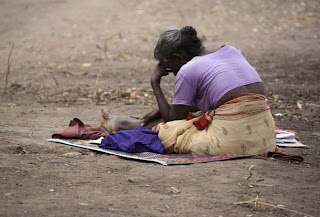People:
Ethnic Composition of People - 81.9% Sinhalese
8% Moor
5.1% Indian Tamils
4.3% Sri Lankan Tamils
0.7% Others
Religious Practised - 76.7% Buddhist
8.5% Muslims
7.9% Hindus
6.1% Christians
0.8% Others
Languages spoke - Sinhala, Tamil & English.
The Indian Tamils of Sri Lanka are partly descended from workers sent from South India to Sri Lanka in the 19th and 20th centuries to work in coffee, tea and rubber plantations. Some also migrated on their own as merchants and as other service providers.
Geography:
Sri Lanka is an island country in South Asia, located about 31 kilometres (19.3 mi) off the southern coast of India.

Tamils are distributed in the North-East (Yellow)
Sinhalese in the central and South-West (Grey)
Economy:
The country is famous for the production and export of tea, coffee, coconuts, rubber and cinnamon. The natural beauty of Sri Lanka's tropical forests, beaches and landscape, as well as its rich cultural heritage, make it a world famous tourist destination.
Introduction to the Civil War in Sri Lanka:

The Sri Lankan Civil War begin on July 23, 1983. There was an on-and-off rebellion against the government by the Liberation Tiger of Tamil Eelam (the LTTE, also known as the Tamil Tigers), a protester aggressive organization which fought to create an independent Tamil state named Tamil Eelam in the north and the east of the island.
Cause of conflict in Sri Lanka:
Tension between Sinhalese and Tamils started during British Colonial rule which favoured the Tamil majority in terms of Jobs and education.
When Sri Lanka became independent, the new government which was made up of mainly Sinhalese, introduced policies which favoured the Sinhalese instead.
1.Policy on Citizen Rights
Citizenship was granted to those born in Sri Lanka or those who forefathers were born there. Many Indian Tamils became stateless despite having lived and worked in Sri Lanka for a long time. They were not citizens of any country and do not have basic rights to education, jobs, housing and voting. Many Indian Tamils continued to work on tea plantations and contribute to Sri Lanka's economy despite being stateless. In 1964, an agreement was drawn up between India and the Sri Lankan government to help the stateless Indian Tamils. However, the Sri Lankan government did not carry out agreement in full.
Tamils felt that the Sri Lanka government was unfair towards them. They had contribute much to the economy but were not recognized by the government as citizens of Sri Lanka. They were treated like second-class citizens and denied access to their basic rights. There was a lot of unhappiness and resentment towards the Sri Lankan government.
Under the British colonial rule, English-educated Tamils could enter the government service and be promoted. They were given senior positions to work in the government even though they were the minority in the country.Sinhalese majority were disadvantaged as they could not read or write English well. In 1956, the Official Language Act ( 'Sinhala Only' policy ) was introduced. This drawn up to improve positions of the majority Sinhalese. Sinhala became the country's official language and used as the only language of administration in Sri Lanka. Tamils in the government service were given 3 years to learn Sinhala or be dismissed.
Tamils were upset and felt that the language policy was unfair to them. They found it difficult to find jobs or be promoted even though they may be as equally qualified as the Sinhalese, felt that their livelihoods were threatened and developed a sense of resentment towards the Sinhalese-dominated Sri Lankan government. Tamils organised a peaceful demonstration which was disrupted by supporters of the Sinhala language. Demonstration turned violent and led to many death.
In 1957,the Official Language Act was hanged. Result of agreement between the Sri Lankan government and the Tamil leader. Terms of the agreement: Tamil was made the language of national minority. Tamils also allowed as language of administration in Tamil-populated areas. Sinhalese protested and demanded that the policy be withdrawn. Led to more fighting between two groups and thus, agreement eventually withdraw in 1958. The Sri Lankan Constitution (1978) has granted a greater degree of recognition to the Tamil language:
i) Declared a national language
ii) Made the language of administration in the northern and eastern provinces
iii) Accepted as an official language (apart from Sinhala and English)
3. University Admission Criteria
Before 1970:
Admission to university was based on merit and examinations were held in English. This benefitted the English-educated Tamils who scored well in exams. Proportion of Tamils was significantly higher han their proportion in the population. Almos equal number of Tamil and Sinhalese students in the more respected medical and engineering courses. Sinhalese were unhappy because enrolment figures were not proportionate to the numbers in the country.
New university admission criteria was introduced in 1970:
Admission was not solely based on academic results. Tamils students had to score higher makrs than the Sinhnaese to enter the same courses. A fixed number of places were reserved for the Sinhalese. Results of new university admission criteria: Percentage of Tamils students admitted to university courses fell, while more Sinhalese entered university.
Tamil Youths were angered by the unfair admission criteria. Tension between youths in the two groups increased. Many Tamil Youths joined the militant group of LTTEto fight against theunfair treatment of the Sinhalese government.
4. Resettlement Policy
Aim of policy was to resettle poor Sinhalese from densely populated southwestern and central areas into tamil-populated areas. To provide land for the landless Sinhalese peasant to live on and cultivate rice. Buddhist monk and the Sri Lankan Army ( mainly Sinhalese) also came to occupy the homeland of the Tamils.
Tamils saw the policy as being unfair to them. They saw the Sinhalese as encroaching into their homeland. They created a lot of resentment among the Tamils. More opportunities for conflict to arise as they lived near each other.
Consequences of the Sri Lankan Conflict
Political Consequence
(i) Armed Conflict

Policies introduced by the Sri Lankan government made Tamils feel that they were discriminated against. They tried to voice out their unhappiness peacefully but were sucessful. Conflict in a country may attract the attention of another country in two ways: The July 1983 riots caused thousands of factory workers, self-employed persons and plantation workers to lose their jobs. Result of the Sinhalese vandalising, looting and burning their places of work such as garment factories. Many People became unemplyed. The conflict resulted in much instability as a result of the use of violence. This led to the loss of confidence by foreign investors to invest in Sri Lanka and resulted in a fall in foreign investment. Violence and internal conflict damaged tourism, one of Sri Lanka's main income earners. Fewer people visited Sri Lanka after the 1983 riots for fear of losing their lives. This resulted in a loss of jobs and fall in earnings. Conflicts has caused many Sri Lankan Tamils to be driven out of their homeland. Many of them fled to Tamil Nadu in South India after the 1983 riots. About 65,000 of them remain as refugees in India today. High Security Zones (HSZ) were set up by the Sri Lankan Army to keep the LTTE away. Access to these areas is highly-controlled. The Sri Lankan army occupied large areas of the Tamil-dominated areas in the north and east of Sri Lanka to take on the LTTE. Lessons that Singapore can learn from the Sri Lanka Conflict: NE2 We must preserve racial and religious harmony. Though many races, religion, languages and cultures, we pursue on destiny. Singapore can learn from the Sri Lanka Conflict by keeping racial harmony to prevent riots in the country. NE6 We have confidence in our future. United, determined and well-prepared, we shall build a bright future for ourselves. Singapore can also learn to stay united no matter what happens and build up Singapore together as one.
In the 1950s, Tamils asked for a federal arrangement within Sri Lanka. Tamil-populated areas to be given political powers but they did not asked for a seperate state.
By 1976, demands of the Tamils were still not met. The Tamil United Liberation Front (TULF), a political party, was formed. They wanted a seperate independent state called Tamil Eelam. They felt that only seperation from Sri Lanka would ensure the rights of Tamils. Proposal was rejected by the Sinhalese government.
Angry and dissatisfied Tamil Youths formed a militant group called the Liberation Tigers of Tamil Eelam (LTTE). They are popularly known as Tamil Tigers. They felt that the use of violence was the only way to demand and obtain their rights. 


The Tamil Tigers attacked both Sinhalese and even Tamils who did not support the proposal for a seperate state. Violence was also carried out by the Sinhalese. Hundred of Tamils lost their lives and property.
It worsened the situation in Sri Lanka and led to war between the LTTE and Sri Lankan government. It prolonged the conflicts for more than 20years. It caused the Sri Lankan people to live in fear for the safety of their lives and properties. It also led to generations of children growing up with strong racial and religious rejudices. These are either passed down by parents or a result of the lack of oppotunitiesto interact and learn about the other party. This made it difficult for Sri Lankans to achieve peaceful solution to resolve their conflict.
(ii) Foreign Intervention
a) To act as a mediator, a neutral party that brings the two sides together for a discussion
b) To interfere directly by sending troops to resolve the conflict.
The Sinhalese-Tamils conflict atracted the attention of its neighbour, India. India's first attempt at mediation started after July 1983 riots. They sent its Foreign Minister to Sri Lanka to mediate in a dialogue between the Sinhalese and Tamils but the dialogue failed.
On 3June 1987, India despatched ships to Jaffna to bring food and petroleum products to the Sri Lankan Tamils. They were turned back by Sri Lankan navy. India then violent Sri Lankan airspace when its Air Force dropped food and medical supplies in Jaffna.
In July 1987, Sri Lanka was pressured into signing a peace accord with India. Terms of the peace accord:
(a) There was to be a ceasefire between Tamil Tigers and Sri Lankan forces.
(b) Tamil Tigers were to surrender their arms to Indian peacekeeping troops.
(c) Tamil-dominated northern provinces were to be merged with the eastern province.
In October 1987, the Tamil Tigers failed to fully surrender their weapons. Indian troops took control of Tiger-controlled Jaffna by force. From October 1987 to December 1988, there were frequent clashes between India Peacekeeping Force and Tamil Tigers. In March 1990, the Indian Peacekeeping Force was withdrawn.
Violation of Sri Lankan airspace demostrated India's disregard for what the Sri Lankan government wanted. The action of the Indian government is worsening the conflict and seen as deliberately taking the side of one group over the other. Clases between Indian Peacekeeping Force and the Tamils Tigers also led to more lives lost in the conflict. Interference of external powers undermind the country's political leadership. This led to the loss of the country's sovereignty and independence.
Economic Consequence
(i) Unemployment
(ii) Loss of investments from other Countries.
eg. Foreign investments fell from US$66million in 1982 to US$22 million in 1986.
Foreign Investments are needed for a country's economy to grow. With lesser investments, Sri Lanka's economy become weak and jobs cannot be generated. The Sri Lankan government would have lesser funds to bring further development to the country. Lesser funds available to develop amentities and facilities such as transport and housing.
(ii) Fall in the number of tourist
The economy was affected adversely. Limited funds were available to develop basic facilities such as transport, housing and power. A fall in economy would result in fewer jobs created and this may lead to fight for jobs between the two groups. Such competition may create more animosity between them, especially since the Tamils faces discrimination in the seeking employment in the government service.
Social Consequences
Standard of living for the Tamils in HSZs is poor. Most live in overcrowded conditions with poor sanitation facilities. Tamil refugees in India have no access to their basic rights of education, employment and proper housing.


